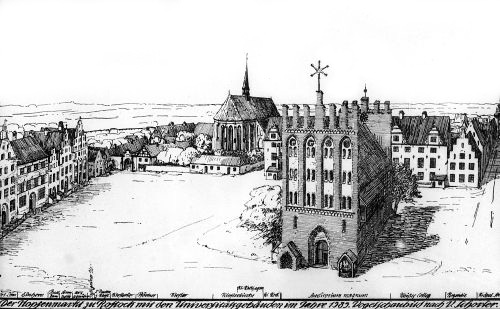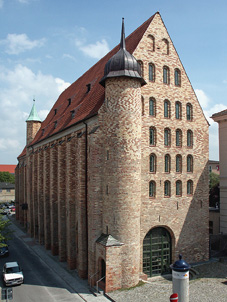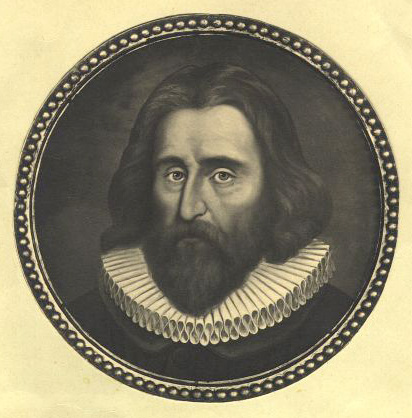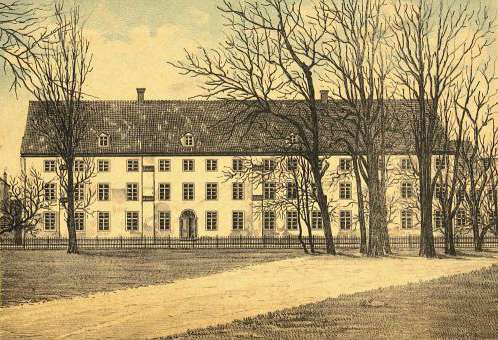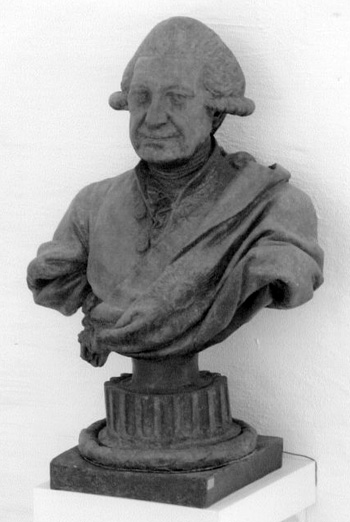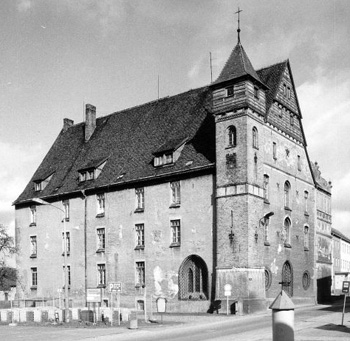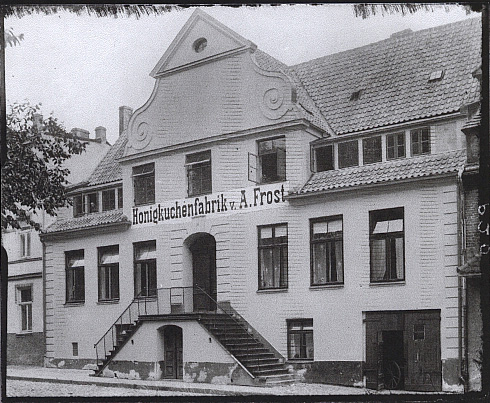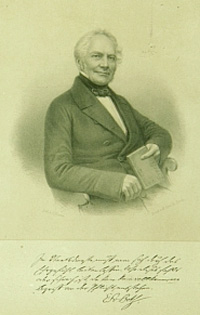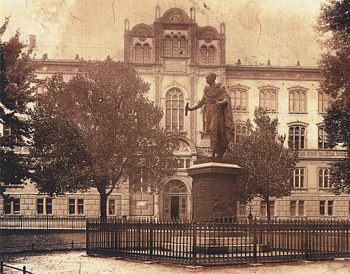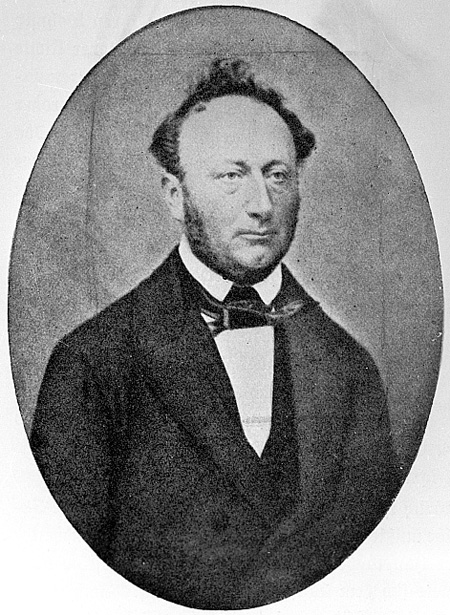06.12.1565
The University lost the building provided by the Bishop of Schwerin in 1419 and used as the “Collegium philosophicum” in a fire. However, a new building (on the site of today's main building) was started in 1566. Larger and more functional, the new building was completed in 1567 and was called the “Collegium Album” (the “White College”), because the whitewashed plaster differed from the usual brick buildings in the city.
1566
The part of the building used by the University was lost due to demolition work on the Johanniskloster (Johannis monastery).
13.07.1569
The beginnings of the University Library date back to the Middle Ages – books were being dedicated “ad librariam Artistarum in Rostock” back in the 15th century. However, the library was established on 13 July 1569. On that day, the Council of the University decided to provide a room to the Dean of the Faculty of Philosophy, Nathan Chyträus, for the “collectio bibliothecae”.
1582
The Faculty of Law was awarded the honour of a count palatine for its dean. This entitled it to audit and appoint notaries (until the Imperial Justice Reform of 1879).
Arround 1582
The Faculty of Artists, which had been teaching the seven liberal arts (the trivium - grammar, arithmetic, geometry; and quadrivium - music, astronomy, dialectics, rhetoric) as well as the Latin language, took on new tasks as the study of the natural sciences developed, and entered the ranks of the upper faculties, becoming the Faculty of Philosophy.
1573/1584
In 1573 and 1584, the strengthening sovereignty of the state led to “inheritance settlements” with the city of Rostock, as a result of which the University was able to strive for peaceful upward development. It achieved supra-regional importance, and the influx of students grew.
Source: 575 Jahre Universität Rostock. Mögen viele Lehrmeinungen um die eine Wahrheit ringen. Rostock 1994, S. 327-328.
Further reading:
550 Jahre Theologie an der Rostocker Universität. Vorträge und Grußworte der Festveranstaltungen anläßlich des 550. Jahrestages der Gründung einer Theologischen Fakultät an der Universität Rostock, hg. von der Wilhelm-Pieck-Universität Rostock. Sektion Theologie, [Rostock] 1983.
Asche, Matthias: Von der reichen hansischen Bürgeruniversität zur armen mecklenburgischen Landeshochschule. Das regionale und soziale Besucherprofil der Universitäten Rostock und Bützow in der Frühen Neuzeit (1500-1800). Stuttgart 2000 (Contubernium, Bd. 52).
Beiträge zur Geschichte der Juristischen Fakultät der Universität Rostock. Materialien eines im Sommersemester 1994 aus Anlaß des 575jährigen Jubiläums veranstalteten Seminars. Rostock 1994.
Boeck, Gisela; Lammel, Hans Uwe; Münch, Ernst; Wagner, Wolfgang E.: Vom Collegium zum Campus. Orte Rostocker Universitäts- und Wissenschaftsgeschichte. Rostock 2007.
Koppmann, Karl: Die Rektoren der Universität und die Dekane der artistischen Fakultät von 1563–1608. In: Beiträge zur Geschichte der Stadt Rostock 3.4 (1903), S. 45-64.
Speicher des Wissens. 444 Jahre Universitätsbibliothek Rostock (Traditio et Innovatio, Sonderausgabe 2013).
12.11.1619
From 12-16 November 1619, celebrations to mark the end of the second century of the University's existence were held. The brilliant success of its resurrection following the Reformation was emphasised.
1622
Joachim Jungius (in Rostock from 1606 to 1628 with periods elsewhere) founded the first German scientific society in Rostock, the “Societas Ereunetica sive Zetetica”.
1627-1630
During the Thirty Years' War, Catholic troops under Wallenstein and Tilly came to Mecklenburg and Rostock in 1627, which had been spared until then. After the sovereigns had left the state, the emperor enfeoffed Wallenstein, the commander of the army, with the hereditary dukedom for both Duchies of Mecklenburg in 1628, upon which he also became Chancellor of the University. Wallenstein resided in Güstrow, but left again in 1629 and had to resign his command in 1630. The sovereigns returned to their ancestral rights in 1631.
25.07.1630
The University celebrated the centenary of the Augsburg Confession, unhindered by the Catholic occupation. The theologian Johannes Klein gave a forceful speech against the papacy.
01.02.1631
When the city commander was murdered under academic jurisdiction by a non-university associate, the autonomous University, being approved by the Pope and confirmed by the Emperor, remained unchallenged.
23.10.1648
The secularisation was confirmed in the peace Treaty of Münster, and the diocese of Schwerin was dissolved. Thus, the chancellorship was transferred to the respective bishop, and supreme supervision of the University was transferred to the ruling sovereigns, who maintained and exercised this power until 1918.
1662
The house of the former “Wasserkunst” on the Grube was given to the University for astronomical purposes (until 1760).
Source: 575 Jahre Universität Rostock. Mögen viele Lehrmeinungen um die eine Wahrheit ringen. Rostock 1994, S. 328-329.
Further reading:
Brodkorb, Clemens: Bistum Schwerin. In: Gatz, Erwin (Hg.): Die Bistümer des Heiligen Römischen Reiches von ihren Anfängen bis zur Säkularisation. Freiburg 2003, S. 670-675.
Jakubowski, Peter: Joachim Jungius und der erste Höhepunkt in der Naturerkenntnis an der Rostocker Universität. In: Wissenschaftliche Zeitschrift der Universität Rostock, Bd. 35 (1986), 9, S. 64-69.
Krabbe, Otto Carsten: Aus dem kirchlichen und wissenschaftlichen Leben Rostocks. Zur Geschichte Wallensteins und des Dreissigjährigen Krieges. Berlin 1863.
1669
The Thirty Years' War had also brought about a shift in power in the Baltic region. Of the Hanseatic League of Cities, almost every one had had to submit to the territorial princes as they withdrew from the Hanseatic world. The Hansa Convention of 1669 was the League’s last.
Following the decline and extinction of the Hanseatic League, the region’s decline in international importance in Europe and the associated decline of the University began. The University lacked the support that would have been necessary for a revival.
11.8.1677
The University lost its law school in the Alter Markt as the result of a major fire in Rostock, which destroyed 700 houses. The Rector, the physician Johannes Bacmeister, lost his house and all its contents, along with all the documents of the Faculty of Medicine stored in the house - an irreplaceable loss for medical history research on the history of the Faculty.
(Kopie 9)
At the beginning of the 18th century, the University saw a modest flourish, but had the image of a small state university of average level, as was the case with other universities of the same size.
1702-1704
In the spring of 1702, Duke Friedrich Wilhelm moved his residence from Schwerin to Rostock and, with his colleges, took over almost the entire university building, the White College, the University itself having to make do just with the ground floor. Even when the Duke had to return to Schwerin two years later, the rooms being used were not released. In addition to disputes with the city council, there were now spatial difficulties.
12.11.1719
On the occasion of the intended celebration of the University's three hundredth anniversary, Duke Karl Leopold announced that this could not take place because of the unrest in the state and would have to be postponed. But even in 1720 the time was not right for a worthy secular celebration, and the celebration still did not take place. Duke Karl Leopold tried every means to transform Mecklenburg into a state with absolute governance and to make the city of Rostock a royal seat. He wanted to eliminate or restrict the superior position of the estates. At the instigation of the knighthood, however, the Imperial Court Council withdrew the power of governance from the Duke and appointed his brother Christian Ludwig as administrator. These so-called “Mecklenburg troubles” formed no basis for prosperous work at the University.
1748-1755
Through skilful politics, Duke Christian Ludwig manage to make the city council concede and, on 20 April 1748, a corresponding settlement was concluded. On 18 April 1755, however, the Duke was forced to sign the notorious “Landesgrundgesetzlichen Erbvergleich” (Basic Law on Inheritance Settlement) - the Magna Carta of the Mecklenburg estates. The settlement constitutionally determined the relationship of the sovereignty with the estates, including Rostock. The settlement act blocked any progressive constitutional development in Mecklenburg.
Source: 575 Jahre Universität Rostock. Mögen viele Lehrmeinungen um die eine Wahrheit ringen. Rostock 1994, S. 329-331.
Further reading:
Asche, Matthias: Bildungsbeziehungen der Hansestadt Lübeck zur Universität Rostock vom 15. bis zum 18. Jahrhundert. Chronik eines regen kulturellen Austausches auf den Spuren der Hanse. In: Lübeckische Blätter, Bd. 164 (1999), 15, S. 221-225.
Kohfeldt, Gustav: Rostocker Professoren und Studenten im 18. Jahrhundert. Schilderungen nach den Akten und nach zeitgenössischen Berichten. Rostock 1919.
Koppmann, Karl: Rostocks Stellung in der Hanse. In: Mecklenburgische Jahrbücher, Bd. 52 (1887), S. 183-208.
Manke, Matthias: Verfassung und Lebenswirklichkeit. Der Landesgrundgesetzliche Erbvergleich von 1755 in seiner Zeit. Lübeck 2006.
Raabe, Wilhelm: Carl Leopold, aus Schwerin vertrieben, residirt in Wismar und Dömitz. In: Raabe, Wilhelm: Specielle Landes- und Volkskunde beider Großherzogthümer, Wismar 1863, S. 1033-1042.
Ziegler, Uwe: Die Hanse. Aufstieg, Blütezeit und Niedergang der ersten europäischen Wirtschaftsgemeinschaft. Eine Kulturgeschichte von Handel und Wandel zwischen 13. und 17. Jahrhundert. Bern 1996.
1760-1789
Duke Friedrich (the Pious), a pronounced supporter of the Halle Pietists, planned to reform the Rostock Faculty of Theology into a breeding ground for the country's pastors in line with Pietism. The Faculty opposed this endeavour, with the support of the entire University and the city council.
As a result, the Duke obtained a patent at the imperial court for a newly founded university with four faculties, which was granted on 3 October 1758. However, it did not imply the annulment of the University of Rostock. In 1760, the Rector and council of the University and the city council were informed of the plan to build a new university in Bützow and to annul the University of Rostock. The baronial professors were summoned to Bützow, and the order was given to close the University of Rostock.
As long as the Duke’s troops were in Rostock, the plan to close the University would be successful. However, when the Prussian troops arrived in Rostock during the Seven Years' War (1756-1763), the Duke's authority became ineffective and the University of Rostock remained intact.
So it was that two universities existed side by side in Mecklenburg, in reality supported only by the opposition between the rulers of the state and the city. In Rostock, the council used what it had at its disposal to revive the remaining part of the University. On the other hand, a commission recommended to the Duke that the University of Bützow be abolished. The Duke died on 24 April 1785 and, without him, the Friedrichs-Universität Bützow lost its support.
1788
The successor to Duke Friedrich, Friedrich Franz I, strove for a settlement of the relationship with Rostock. The “Grundgesetzliche neue Erbvertrag” (New Constitutional Inheritance Contract), concluded on 13 May 1788, ended the city's struggle against state sovereignty. The University itself had not been heard during the preparatory consultations for the conclusion of the new inheritance contract, even though it also affected the University. The agreement was:
- that the University of Bützow would return to Rostock and that the reunited University in Rostock would be and remain the only one in the state;
- that the sovereign would be Patron and Chancellor of the University;
- that the city’s Kompatronat (common patronage) would be preserved;
- and that the former division of the teaching staff should be abolished.
1789
Teaching in Rostock began on 28 April 1789. The rooms in the university building being used for the purposes of the state government were vacated. To accommodate the Justice Chancellery housed in the White College, the University had to give up the building in Langen Strasse. This was later replaced by a new building for Rostock Higher Regional Court.
The term of office for rectors and deans - previously one semester - was set at one year.
On 4 December 1789, the Duke appointed Adolph Friedrich Loccenius, Director of the Chancellery involved in the negotiations for the merger, as the first Vice-Chancellor (Curator) of the University, who, as the state supervisory officer, was to supervise all processes at the University in addition to the fixed individual tasks.
Loccenius was eager, but less than successful, in fulfilling his mission. When he died on 2 July 1793, no successor was appointed.
1789/1790
The Faculty of Law building in the Alter Markt, which was destroyed in the fire of 1677, was converted into the Anatomical Institute of the Faculty of Medicine. So it was that the Faculty received its first dedicated building on 3/11/1790.
1790
Franz Christian Lorenz Karsten, Professor of Economics (Agriculture, in Bützow 1775-1789 and in Rostock 1789-1828), was one of the first people in Germany to give lectures on agriculture. He set up a small agricultural experimental station for the practical training of students. However, there was no financial support from the State or the University.
Source: 575 Jahre Universität Rostock. Mögen viele Lehrmeinungen um die eine Wahrheit ringen. Rostock 1994, S. 331-332.
Further reading:
Asche, Matthias: Die mecklenburgische Hochschule Bützow (1760-1789) - nur ein Kuriosum der deutschen Universitätsgeschichte? Versuch einer historischen Neubewertung. In: Jahrbuch für Universitätsgeschichte, Bd. 9 (2006), S. 133-147.
Camenz, Günter: Zur Geschichte der Universität "Fridericiana" in Bützow 1760-1789. Bützow 1999.
Hölscher, Uvo: Urkundliche Geschichte der Friedrichs-Universität Bützow. In: Mecklenburgische Jahrbücher, Bd. 50 (1885), S. 1-110.
Velthusen, Johann Kaspar: Nachricht von der Stiftung eines Herzoglichen pädagogisch theologischen Seminariums auf der Universität Rostock. Rostock 1790.
Wegner, Christoph: Franz Christian Lorenz Karsten. Eine kritische Biographie. In: Buchsteiner, Martin (Hg.): Zur Entstehung der Agrarwissenschaft. Beiträge zu Leben und Werk von Franz Christian Lorenz Karsten und Johann Nepomuk Hubert (von) Schwerz. Norderstedt 2010, S. 55-111.
Wegner, Richard N.: Zur Geschichte der anatomischen Forschung an der Universität Rostock. Wiesbaden 1917.
Around 1800
When numerous German universities had to close at the beginning of the 19th century, the University of Rostock remained intact, but had to struggle for its existence.
1800
The journeyman riots in Rostock in 1791-1795 needed military intervention to be put down. The so-called “Butter Revolution” took place in 1800. The city council requested help from the University, and students were appointed to restore order. At the same time, the University provided the “Auditorium Magnum” on the University Square, to accommodate more than 100 prisoners. After it became vacant, the University suggested demolishing the dilapidated building.
1806
The Napoleonic Wars diverted attention. French troops occupied the whole country in 1806. The University had to hand over the Anatomical Institute in the Alter Markt to the French occupying forces, as well as the Auditorium Magnum, which was first used as a military hospital, and later as a recruiting depot.
1812
In 1812, the Convictoria building in the Johannis-Kloster was confiscated for military purposes. After their defeat in Russia, the French troops withdrew, and Russian troops occupied Mecklenburg. The Duke lifted the Napoleonic Continental Blockade and announced the dissolution of the Confederation of the Rhine. Students registered as volunteers, and lectures at the University were interrupted.
1813
After Napoleon’s defeat at Leipzig (16/10/1813), the University returned to settled work again.
1815
During the Wars of Liberation, the idea of German unity was awakened among the students. In 1815, a unified fraternity was founded in Jena, followed by the “Rostochia”, founded in Rostock in 1812. The activities of the fraternity drew the attention of the governments of the countries of the “German Confederation” and hinted at “signs of imminent revolution”.
1818
The building of the Anatomical Institute in the Alter Markt, which was used as a military hospital by the Napoleonic troops, was not taken back into operation until 1818, following necessary repairs, thus giving the medical students a place for practical training.
Source: 575 Jahre Universität Rostock. Mögen viele Lehrmeinungen um die eine Wahrheit ringen. Rostock 1994, S. 333-334.
Further reading:
Höffer, Volker: Das studentische Verbindungswesen an der Universität Rostock vom Ausgang des 18. Jahrhunderts bis zum Vorabend der bürgerlich-demokratischen Revolution in Deutschland. Rostock 1987.
Hoppe, Klaus-Dieter; Nenz, Cornelia; Weiß, Detlef (Hg.): Franzosenzeit in Mecklenburg. Begleitkatalog zur ständigen Ausstellung "Franzosenzeit in Mecklenburg" des Fritz-Reuter-Literaturmuseums im Gewölbe des Stavenhagener Schlosses. Rostock 2007.
Manke, Matthias; Münch, Ernst (Hg.): Unter Napoleons Adler. Mecklenburg in der Franzosenzeit. Lübeck 2009.
Reincke-Bloch, Hermann: Mecklenburg zu Beginn der Freiheitskriege. Rede gehalten in der Aula der Universität am 28. Februar 1913 bei der akademischen Feier zur Erinnerung an die Befreiungskriege. Rostock 1913.
1819
In August 1819, under the leadership of the Austrian Prince Metternich, a ministerial congress took place, which established the notorious Carlsbad Decrees on the supervision of German universities and the introduction of press censorship. In September 1819, these were elevated to provisional federal resolutions in Frankfurt am Main, and the governments were required to suppress the Allgemeine Deutsche Burschenschaft fraternity by any means. Each university was expected to have an extraordinary sovereign representative with appropriate instructions and extensive powers. The Chancellery Councillor Friedrich von Schmidt, governor of the Hereditary Grand Duke of Rostock, was appointed to the role on 15 November.
26.8.1819
The dilapidated Auditorium Magnum had to be demolished for the erection of a monument to Field Marshall Blücher - the first in Germany. As a replacement, the Marienkirche was made available to the University for ceremonial events and public debates. When the Blücher monument was inaugurated on 26 August 1819, the participating students behaved “so decently and orderly” that the Grand Duke praised their behaviour.
12.11.1819
The celebration of the 400th anniversary of the foundation of the University took place on 11-13 November 1819, in a modest setting for financial reasons.
Government Representative von Schmidt had previously had to report to Schwerin that there had been a fraternity organisation in Rostock since 1812, but it had no political interests, and it had been dissolved. In the assessment of the forbidden student associations that were repeatedly formed in later years, the attitude of the University management, the government representative and also the Grand Duke (this rank had been conferred on the sovereign at the Vienna Congress) showed that they were willing to apply the required measures against the students only when absolutely necessary and to show leniency.
1820
On 16 September 1820, Legation Councillor von Schmidt was dismissed from the position of government representative; on 12 October 1820, the Deputy Director of the Rostock Justice Chancellery, Karl Friedrich von Both, was entrusted with this position. In 1836, he was also appointed Vice-Chancellor (Curator) of the University, and over a 50-year term he earned credit for the University and its preservation. (Ducal Instructions for von Both)
Source: 575 Jahre Universität Rostock. Mögen viele Lehrmeinungen um die eine Wahrheit ringen. Rostock 1994, S. 334-335.
Further reading:
Büssem, Eberhard: Die Karlsbader Beschlüsse von 1819. Die endgültige Stabilisierung der restaurativen Politik im Deutschen Bund nach dem Wiener Kongreß von 1814/15. Hildesheim 1974.
Grotefend, Hermann: Zur Geschichte der Rostocker Burschenschaft. In: Mecklenburgische Jahrbücher, Bd. 84 (1919), S. 123-130.
Koppmann, Karl: Zur Geschichte des Blücher-Denkmals in Rostock. [Rostock] 1909.
Kurth, Alexandra: Männer - Bünde - Rituale. Studentenverbindungen seit 1800. Frankfurt am Main u.a. 2004.
Schmidt, Martin H.: Das Blücher-Denkmal in Rostock von Johann Gottfried Schadow. In: Gebhard Leberecht von Blücher und seine Zeit. [zum 250. Geburtstag], [Red. Wolf Karge]. Rostock 1992, S. 19-42.
26.1.1823
A fire destroyed the house of the Rector, Professor Pries, and very little could be saved. In the evening the students decided to make the sum of 330 talers collected for a student ball available to the Rector as a donation, in order to make the loyalty of the student body clear to the government representative.
09. to 13.02.1823
On 9 February there was a serious clash between students and military personnel. Since the students did not believe that the soldiers were being dealt with forcefully enough, they left the city on 13 February and turned to Bützow. On the request of the Grand Duke, and after the adoption of a declaration of discredit, the students returned to Rostock in mid-March.
1825
When Professor Heinrich Spitta came to Rostock in 1825, he succeeded in obtaining permission from the city's Armenkollegium to run an outpatient clinic with the participation of the students in the Municipal Hospital in Grubenstrasse.
July 1826
The Government Plenipotentiary was instructed to audit all funds and associated records, the proper use of the funds and their secure allocation. There was no objection on behalf of the University. The first step for the state government to exert influence on the financial administration of the University was taken.
Source: 575 Jahre Universität Rostock. Mögen viele Lehrmeinungen um die eine Wahrheit ringen. Rostock 1994, S. 335-336.
Further reading:
Hückstädt, Arnold: Fritz Reuter und die "Allgemeinheit", John Brinckman und die "Gesellschaft der Volksfreunde". Rostocker Studentenverbindungen zwischen 1831 und 1834. In: Brunners, Christian (Hg.): Fritz Reuter, John Brinckman, Dethloff Carl Hinstorff und Rostock. Rostock 2002, S. 8-24.
Jügelt, Karl-Heinz: Bibliotheca Philosophica - Bibliotheca Academica - Universitätsbibliothek. Bücher, Bibliothekare und Ereignisse in der 425jährigen Geschichte der Universitätsbibliothek Rostock. In: Mögen viele Lehrmeinungen um die eine Wahrheit ringen. Hrsg. vom Rektor der Universität Rostock. Rostock 1994, S. 40-69.

